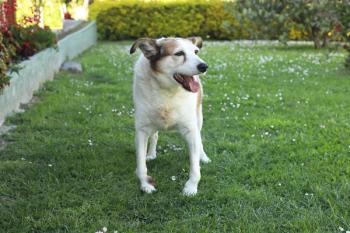
Regional oral anesthesia and pain management (Proceedings)
Many of our patients in veterinary dentistry are older or have compromised core body functions.
Regional anesthesia
Many of our patients in veterinary dentistry are older or have compromised core body functions. It is important to choose an anesthetic regimen that will provide these animals with the least risk and offer adequate analgesia intraoperatively and postoperatively. Regional anesthesia is an excellent adjunct to general inhalation anesthesia because it will:
1.) allow the anesthetist to reduce systemic anesthesia levels (and risks) while providing appropriate analgesia.
2.) act to create vasoconstriction (lidocaine) which will enhance hemostasis.
3.) combine with other drugs to aid in hemostasis and prolong analgesia (dilute epinephrine 1:100,000). Caution in hyperthyroidism or cardiac disease.
4.) provide long lasting postoperative analgesia (bupivicaine).
5.) dramatically decrease the cost of inhalant anesthesia.
Dosage
Bupivicaine – Cats = 2 mg/kg. (caution – never exceed as a total dosage).
Dogs = 2 to 6 mg./kg.
Syringe and 22 - 25 gauge x ¾ to 1-½ inch hypodermic needle
Technique
All regional nerve blocks as described below are performed intraorally as opposed to percutaneously in our practice.
1. ) Cranial infraorbital block - PM⅔ and area mesiad including: dentition, maxilla and intraoral soft tissues; extraoral soft tissues blocked include nose, upper lip, and skin ventral to infraorbital foramen. Nerves blocked include infraorbital nerve, rostral and middle maxillary alveolar nerve. Palpate infraorbital foramen as a depression in the alveolar mucosa apical (dorsal) to distal root of PM3. Aspirate in at least two planes, then slowly infuse drug (0.1 – 0.3 mL) into the infraorbital canal. Studies have shown that better analgesia is produced when the canal is infused rather than infiltration of the area rostral to the foramen. Care must be taken to prevent intravascular infusion.
Rostral mandibular block
2.) Caudal infraorbital block - M2 and area mesiad (maxillary quadrant) including: dentition, maxilla, mucosa of the hard palate and intraoral soft tissues; extraoral soft tissues blocked include nose, upper lip, and skin ventral to infraorbital foramen. Nerves blocked include: infraorbital nerve, rostral, middle and caudal maxillary alveolar nerves. Palpate the distal margin of the zygomatic arch and direct the hypodermic needle from the gingiva caudal to M2 towards the distal zygomatic arch and infiltrate. Another technique that results in more accurate drug placement is passage of the needle caudally within the infraorbital canal. Aspirate 360o prior to slow infusion of drug (0.1-0.3 mL). Care must be taken not to traumatize the neurovascular bundle. Apply digital pressure to the rostral opening of the canal for one minute.
Caudal mandibular block
3. ) Mental regional block - PM2 and area mesiad including: dentition, mandibular bone and intraoral soft tissues; extraoral soft tissues blocked include lower lip. Nerve blocked: mental nerve. Palpate the middle mental mandibular foramen (largest and most easily palpable of the 3 mental foramina) apical (ventral) to mesial root of PM2, just caudad to the fleshy mandibular labial frenulum. May be hard to appreciate middle mental foramen especially in cats; can confirm needle placement with intraoral radiography or alternatively if dental radiography unavailable, place needle midfrenulum adjacent and parallel to the mandible. Insert hypodermic needle into the foramen, aspirate, then slowly infuse (0.1-0.3 mL). Care must be taken to prevent intravascular infusion. Apply digital pressure over injection site for 60 seconds in order to ensure maximum caudal/distal diffusion of local anesthetic into the mandibular canal.
Rostral maxillary block
4.) Mandibular alveolar block – Caudal body of mandible cranial to the mandibular foramen and area mesiad including: dentition, mandibular bone, and intraoral soft tissues including extraoral tissues blocked include lower lip (skin and mucosa) and chin (skin and mucosa). Blocks the inferior alveolar branch of the mandibular nerve. Palpate the notch on the base of the coronoid process (palpable lip of mandibular foramen). Direct a hypodermic needle from the gingiva lingual and distal to M3 staying along the medial aspect of the ramus of the mandible to the area palpated. Aspirate as above, then slowly infiltrate. Because this foramen and nerve may be difficult to palpate, placing the local anesthetic alongside periosteum of the body of the mandible will cause the local anesthetic to spread over a large surface area. Apply digital pressure at injection site for 60 seconds in order to ensure rostral/mesial diffusion of agent into mandibular canal.
Caudal maxillary block
5.) Major palatine nerve block – palate and palatal gingiva at PM4 and area mesiad. Blocks the major palatine nerve. Imagine a line connecting the mesial edge of the maxillary M1 teeth. Palpate the major palatine foramen at a point on the line midway between the palatal midline and the maxillary dental arch. The major palatine nerve lies in a trough superficial to the palatal bone and deep to the hard palate. This block is unnecessary when a caudal infraorbital block is placed caudal to the branching of the maxillary trunk of the trigeminal nerve into the major and minor palatine nerves.
6. ) Alveolar block – individual alveoli may be anesthetized by insertion of a 25 to 27-gauge needle into the periodontal ligament space, slowly and forcefully infusing local anesthetic into the space. This technique is used less often due to the ease of accessing the above sites.
Bupivicaine will take affect within 4 to 8 minutes and will last 6 to 10 hours. Despite some reports indicating that animals are more at risk for self-trauma to the locally anesthetized area during recovery from general anesthesia, this is not a typical response. Self-trauma occurs only when a block is made with excessive volume of drug or lack of attention to specific anatomical landmarks.
Pain management
What is pain? It has been described by the International Association for the Study of Pain (IASP) as an unpleasant sensory and emotional experience associated with actual or potential tissue damage. This group also states that the inability to communicate in no way negates the possibility that an individual is experiencing pain and is in need of appropriate pain relieving treatment. The "pain experience" can be grouped into the following categories: nociception which includes transduction, transmission and modulation, perception of the unpleasant experience and behavioral responses to pain.
Transduction is the process that involves translation of noxious stimuli into electrical activity at sensory nerve endings. Nociceptors respond to thermal, mechanical and chemical stimulation. Transmission is the process of sending the impulses throughout the sensory nervous system. Afferent signals from the periphery are relayed through the dorsal root ganglia to the dorsal horn of the spinal cord where sensory input can be modulated. Information travels rostrally, finally reaching the cerebral cortex. Modulation is the modification of nociceptive transmission. The body can regulate and modify incoming impulses at the dorsal horn by the release of enkephalins or natural opioids along with activation of the serotonergic and noradrenergic pathways. The logical approach to treatment of pain is based upon manipulation of these processes.
Understanding peripheral and central sensitization explains much about an animal's response to injury and allow for better pain management. The use of multi-modal pain management will enhance the patients comfort during and after surgery while decreasing the risk and cost general anesthesia. Surgery produces inflammation and changes the sensitivity to noxious stimuli. As the local area of tissue injury becomes more sensitive, the threshold for subsequent stimuli decreases or a state of hyperalgesia. This condition may spread to other parts of the body. Peripheral sensitization is a result of inflammatory mediators. When neurons in the dorsal horn are repeatedly stimulated, this is called central hypersensitization or the "wind up theory" of pain. One specific receptor is the N-methyl D-aspartate (NMDA) receptor in the spinal cord. Ketamine is a non-competitive NMDA antagonist which has shown benefit in prevention of pain "wind up.".
Opioids have been shown to have a direct local analgesic effect in peripheral tissues. Opioid receptors can be found on peripheral nerves and on inflammatory cells but are not obvious until after the onset of inflammation. Proper selection of premedications and induction agents can have a preemptive affect on pain management. The incision we make begins the transduction process of pain. If we preempt pain, less mediators of inflammation will be released peripherally, sending fewer signals to the dorsal horn. Ketamine has been found to be an important analgesic in blocking the NMDA receptor mechanism decreasing "wind up" pain. Opioids can modulate pain locally and centrally. Local anesthesia agents will inhibit transmission of pain to the spinal cord. Anti-inflammatory drugs are known to act both peripherally at the site of inflammation and centrally to modulate spinal transmission. These drugs are important in treating both acute and chronic pain. The alpha-2 agonists like medetomidine are very potent and selective (both visceral and somatic) analgesics. The duration of activity is approximately 3 hours. The ability to reverse medetomidine with atipamezole is an additional benefit when using this analgesic modality. By using multi-modal therapy we can dramatically decrease pain with each drug acting at a different site along the pathway.
Opioid, NSAIDs or alpha-2 agonist drugs can and should be used for analgesia in conjunction with regional anesthesia. Common drugs used perioperatively are:
• Medetomidine 1 mg/ml IV or IM (Atipamezole 5 mg/ml IM – reversing agent)
• Carprofen 2 mg/kg S/Q
• Ketoprofen 1 mg/kg IV, IM or S/Q
• Buprenorphine Dog: 0.006-0.02 mg/kg IV, IM or S/Q q4-8 hrs
• Cat: 0.005-0.01 mg/kg IV, IM q4-8 hrs
• Oxymorphone 0.05-0.1 mg/kg IV, IM or S/Q
• Hydromorphone Dogs: 0.1-0.2 mg/kg
• Cats: 0.05-0.1 mg/kg
• Morphine Dogs: 0.1-1.0 mg/kg IV, IM or S/Q q4-6 hrs
• Cats: 0.1-0.2 mg/kg IM, S/Q q3-6 hrs
• Butorphanol 0.2-0.6 mg/kg IV, IM or S/Q
• Fentanyl intradermal patch – begin 12 hours prior to surgery- 4ug/kg/hr patch
• Ketamine 2.0-6.0 mg/kg IV or IM
Medical, financial and environmental benefits
The ability to obtain hours of postoperative pain management and the reduction of intraoperative general anesthesia while providing excellent surgical analgesia has tremendous medical, financial and environmental benefits for the practice of veterinary dentistry. Clients appreciate the alert state of their pet at the discharge appointment.
Post operative pain management
Oral medications for continued pain control are much easier to administer while the regional anesthesia is present. Discharging patients who have several hours of regional anesthesia duration remaining can be given oral pain medications with food. Some common analgesics for oral use are:
• Carprofen (Rimadyl) 2 mg/kg bid
• Ketoprofen (Orudis) 2 mg/kg sid load dose followed by 1 mg/kg sid
• Deracoxib (Deramaxx) 1.0-4.0 mg/kg sid (high dose for acute, low for chronic)
• Etodolac (Etogesic) 10-15 mg/kg sid
• Tepoxalin (Zubrin) 20 mg/kg sid load dose followed by 10 mg/kg sid
• (Osteoarthritis labeling)
• Meloxicam (Metacam) 0.2 mg/kg sid load dose followed by 0.1 mg/kg sid
• MS Contin 0.5 mg/kg bid
• Tramadol 1-5 mg/kg qid-bid
• Buprenorphine 5-40 µg/kg (drops for sublingual absorption to affect in cats)
Excellent post operative pain management can be achieved with opioids and NSAIDs given concurrently for 3 to 5 days after surgery followed by 4 to 5 additional days of NSAID therapy.
• Veterinary Dentistry Principles and Practice by Wiggs and Lobprise
• Veterinary Dental Techniques by Holmstrom, Frost and Eisner
• Handbook of Veterinary Anesthesia by Muir, Hubbell and Skarda
• Regional Nerve Blocks for Oral Surgery in Companion Animals in Comp Cont Ed Prac Vet 24:6 2002 by Beckman and Legendre
• Local Dental Anesthesia, AVDF 2000 by Haws
• Current Veterinary Therapy XIII by Bonagura
• Kohrs R and Durieux ME. Ketamine: teaching an old drug new tricks. Anesth Analg 1998, 87(5);1186-93
Newsletter
From exam room tips to practice management insights, get trusted veterinary news delivered straight to your inbox—subscribe to dvm360.






